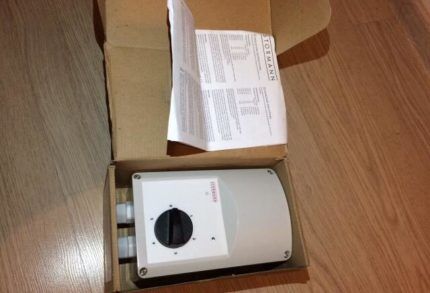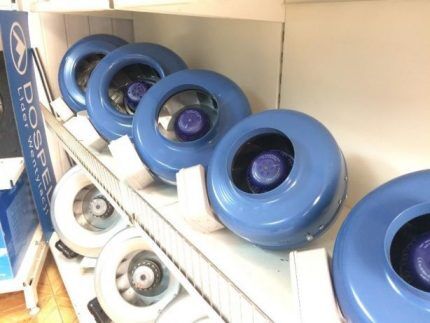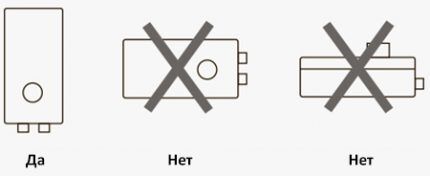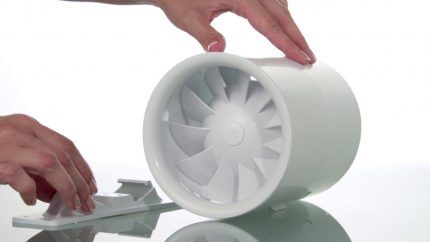Adjusting the speed of the duct fan: connecting the controller and setting the hood speed
Duct fans are used to ensure air movement in the room.Simple devices are effective and are used in residential, commercial, and industrial buildings. But sometimes it is necessary to adjust the speed of a duct fan: to save energy, reduce the level of acoustic noise, adjust the performance of the supply and exhaust.
One way to change the degree of rotation of the blades of the device is to use a step controller. Let's see how it works, where it is used, what are the advantages and disadvantages of the device, what types there are. Let's take a look at some connection diagrams for such devices and installation-related nuances. All this will help you select and install the regulator correctly.
The content of the article:
Feasibility of using the device
When the fan constantly operates at maximum speed, the resource of the device is quickly exhausted. The power of the device decreases and it fails. Most parts cannot withstand such a load, wear out, and break. Speed controller installation increases service life fan
In addition to saving working resources, the regulator also performs another important function - reduces noise from a running ventilation system.

Another compelling reason for installing a regulator is energy saving. The result of reducing the number of revolutions of the blades and changing the total power of the device is a reduction in energy consumption.
Operating principle of a step regulator
The operation of the device is based on the application transformer, which is equipped with one winding, taps from the turns. The winding is branched. When connecting the branches to the hood, a reduced voltage is supplied.
The step adjustment itself is carried out by changing the turns, which are connected to the fan input.

As the voltage decreases, the rotation speed of the hood blades also decreases. At the output we get an undistorted sine wave, so when switching speeds there is no interference that affects other devices and the fan itself.
Other types of regulators use a different principle. IN electronic modules PWM action is based on varying the instantaneous power transmitted to the load. IN semiconductor devices the operating function is based on thyristors and triacs.

The device is controlled by a stepwise, phased change in the supply voltage. Adjustment is made manually.
The controllers are mounted on the wall like switches, with their help it is easy to change the number of revolutions of the exhaust fan.
Using a special switch, the fan is connected to the desired winding unit and the rotation speed of its blades decreases. At the same time, energy consumption is reduced, which saves resources.
The advantages of the models include reliability, durability, and high overload capacity. The disadvantages include the size of the control unit: this is not always convenient if the device needs to be placed in a limited space.
Two more disadvantages are the impossibility of smooth adjustment and energy loss due to heating during adjustment. But when connecting temperature sensors and a timer, the process of changing speeds is easy to automate.
Types and features of devices
Transformer regulators are ideal for situations where you need to control the speed of rotation of the hood blades manually. Their popularity is due to their moderate cost, as well as the highest reliability among their “colleagues”.

The difference between step controllers and others types of regulators — the ability to work continuously for a long time at unattended facilities.
Main technical characteristics of the devices:
- stepped voltage: 65-110-135-170-230 or 80-105-130-160-230 (numbers differ depending on the model);
- single-phase and three-phase - 220 and 380 V, respectively;
- weight can be up to 30 kg (all devices are quite bulky);
- current frequency: 50–60 Hz;
- device protection class: 00, 20, 54 IP.
The device cases are made of durable plastic and can withstand temperatures up to +40 degrees. Some groups of regulators belong to class B with a shutter speed reserve of up to 130 degrees.

Some models are equipped with equipment operation warning lamps and emergency indicators. There are also unique devices with the option of galvanic isolation from the network. Such controllers can be used in medical institutions.
As additional options, the controller may have terminals for connecting and controlling external devices (for example, for air damper drives).
Based on the design and type of fans serviced, controllers are divided into installed ones:
- on the walls;
- inside the walls;
- inside the ventilation unit;
- in a separate special cabinet if the system is working "smart House".
Some models are mounted on a Din rail and controlled remotely.
If you need to regulate the speed of several fans, it is advisable to buy a multi-channel controller. There are models that can serve up to four or more devices simultaneously.

But, if the fans are located in different rooms, and there is one regulator, then the parameters on the hoods will be set to the same. In cases where different microclimates are needed in different rooms, it is more convenient to connect several controllers.
The large weight and dimensions of such devices and the complexity of external control are offset by their advantages when placed in a stationary location. The choice of a specific model depends on the technical features of the ventilation system.
Connecting the controller to the hood
The device is installed indoors. It is produced taking into account the recirculation of air masses to cool the internal circuits.

To install the regulator correctly, you must carefully read the instructions for the device.
Most models are designed for self-installation by the user and do not require special knowledge.

Installation of wall and in-wall devices is carried out using screws and dowels, which are selected in accordance with the dimensions and weight of the device. Fastening elements are usually included in the kit, as is a wiring diagram for the fan controller.
The general pattern and sequence of actions is as follows:
- The regulator is first mounted, then connected to the cable that supplies current to the fan.
- The wires are divided into “phase”, “zero”, “ground” and cut, connected to the input and output terminals. It is important not to confuse them and make all connections according to the instructions.
- The last stage is to check the cross-sectional size of the power cable and connection for compliance with the maximum permitted voltage of the device.
The process for installing wall regulators is similar to the principle connecting sockets, lighting switches. You can use the old fan switch seat to mount the controller. In this case, the switch must be removed.

If the controller has thermal contacts, it is recommended to connect it to motors with external thermal protection contacts connected to the TK terminals of the regulator. This circuit will reliably protect the main device.
When the thermal contacts open due to overheating, the controller circuit is broken, the engine immediately stops and the warning light comes on.
A motor without thermal contacts requires the installation of separate thermal protection. Additionally, a jumper on the TC can be added to the circuit, but the rated current of the regulator must be 20% greater than the maximum motor current.
How to reduce or increase speed?
In hoods, thanks to stepwise adjustment of the fan speed, you can change the flow intensity, which affects the overall air exchange. For control, a method of changing voltage is used.
The effectiveness of the device has been proven in practice. A simple and inexpensive device suitable for domestic and public premises. It can also perform additional functions.

The speed is increased or decreased mechanically. The modules have a wheel for stepwise changing the speed of the hood motor.
Before connecting power, check the wire connections and grounding efficiency. It is not recommended to turn the power on or off frequently: continuous operation of the regulator ensures optimal temperature and prevents condensation from forming in the device body.
If the device does not have an automatic restart function and overheating occurs, the reasons must be eliminated. The switch is set to zero while the engine is cooling, then the device is restarted.
Recommendations for reducing noise levels
Often the desire to adjust the fan speed is associated with the increased noise level that the device produces. The device should “sound” in the range of up to 55 dB. Normal level is 30-40 dB.

The regulator does not actually reduce the noise: at maximum speed the fan makes the same sound as before. It runs quieter at lower speeds.
In order to reduce the noise level from the hood even at maximum speed, you need to check the tightness of the attachment of the main device body to the wall, a special niche. Gaps can be sources of additional vibration.
These gaps are sealed with foam rubber or polyurethane. It is also useful to inspect the fastening elements, which must be well tightened. Reduces noise and thin isolon substrate in a vibrating surface.
And the most effective way to reduce the noise of the hood is to choose silent duct fan.
Conclusions and useful video on the topic
How to connect the regulator to the fan.The example shows a thyristor controller, but the connection principle will help you understand the algorithm for working with a step device:
Features of connecting a duct fan via a speed controller + two more methods are discussed in the following video:
Step-by-step fan speed control makes the system less energy-consuming, quieter, and more precisely controlled. The controller ensures the safety of the main equipment and increases its service life. This is facilitated by safe start-up, protection against short circuit, overcurrent, overvoltage, and open-phase operation.
The cost of purchasing the device is offset by savings on energy consumption. It is only important to select the regulator parameters for the fan being serviced. Most manufacturers have model correspondence tables that you can use when purchasing them yourself. Consultation with the store manager does not fit either..
Do you have any questions about the topic of the article? Ask them to our experts and other site visitors - the feedback block is located below. Also here you can share your own experience and theoretical knowledge, and participate in discussions.




Hello, we bought a verakso brand hood (it has a centrifugal fan with the following characteristics: Throughput - 800 m3/hour
Power consumption - 80 W
Noise level - 74 dB
Hood dimensions - 41/31/13.3 cm (l/w/h)
Voltage - 220 Volts). After the first use, it became clear that the noise from it was very loud, and there was no speed control. A representative of the hood manufacturer stated that if the regulator is installed on this type of engine, it (the engine) will quickly fail. Is this true?